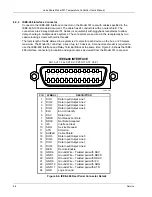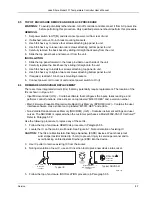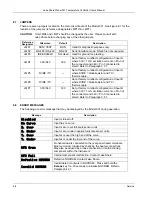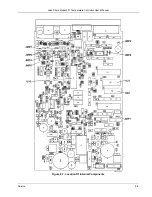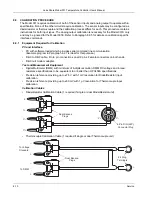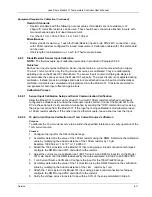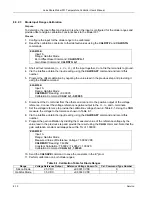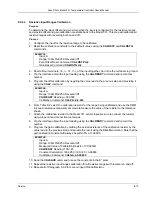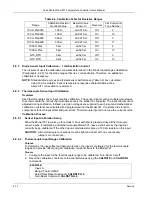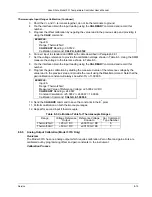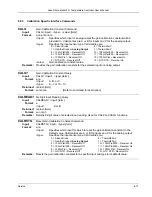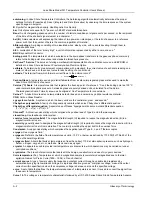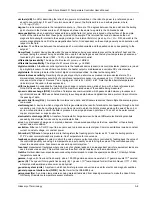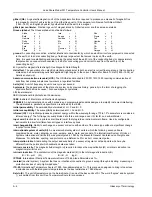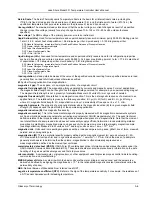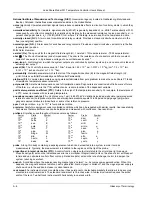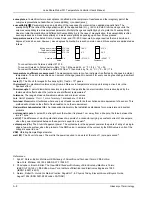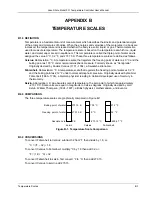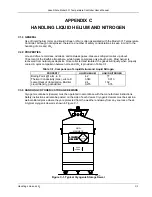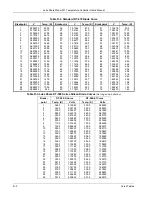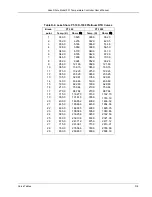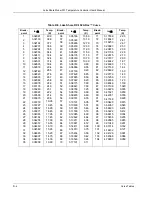
Lake Shore Model 331 Temperature Controller User’s Manual
autotuning
. In Lake Shore Temperature Controllers, the Autotuning algorithm automatically determines the proper
settings for Gain (Proportional), Reset (Integral), and Rate (Derivative) by observing the time response of the system
upon changes in setpoint.
B
. Symbol for magnetic flux density.
See
Magnetic Flux Density.
bar
. Unit of pressure equal to 10
5
pascal, or 0.98697 standard atmosphere.
Baud
. A unit of signaling speed equal to the number of discrete conditions or signal events per second, or the reciprocal
of the time of the shortest signal element in a character.
2
bel (B)
. A dimensionless unit expressing the ration of two powers or intensities, or the ratio of a power to a reference
power, such that the number of bels is the common logarithm of this ratio.
1
bifilar windings
. A winding consisting of two insulated wires, side by side, with currents traveling through them in
opposite directions.
1
bit
. A contraction of the term “binary digit”; a unit of information represented by either a zero or a one.
2
BNC
. Bayonet Nut Connector.
boiling point
. The temperature at which a substance in the liquid phase transforms to the gaseous phase; commonly
refers to the boiling point at sea level and standard atmospheric pressure.
CalCurve™ Service
. The service of storing a mathematical representation of a calibration curve on an EEPROM or
installed in a Lake Shore instrument. Previously called Precision Option.
calibrate
. To determine, by measurement or comparison with a standard, the correct value of each scale reading on a
meter or other device, or the correct value for each setting of a control knob.
1
cathode
. The terminal from which forward current flows to the external circuit.
2
Anode
Cathode
+
–
Carbon-Glass
. A temperature sensing material fabricated from a carbon-impregnated glass matrix used to make the
Lake Shore CGR family of sensors.
Celsius (°C) Scale
. A temperature scale that registers the freezing point of water as 0 °C and the boiling point as 100 °C
under normal atmospheric pressure. Celsius degrees are purely derived units, calculated from the Kelvin
Thermodynamic Scale. Formerly known as “centigrade.”
See
Temperature for conversions.
Cernox™
. A Lake Shore resistance temperature detector based on a ceramic-oxy-nitride resistance material.
CGR
. Carbon Glass Resistor.
cgs system of units
. A system in which the basic units are the centimeter, gram, and second.
2
Chebychev polynomials
. A family of orthogonal polynomials which solve Chebychev’s differential equation.
1
Chebychev differential equation
. A special case of Gauss' hypergeometric second-order differential equation:
(1 – x
2
) f" (x) – xf' (x) + n
2
f (x) = 0.
1
Chromel™
. A chromium-nickel alloy which comprises the positive lead of Type E and K thermocouples.
closed-loop
.
See
feedback control system.
coercive force
(coercive field)
. The magnetic field strength (H) required to reduce the magnetic induction (B) in a
magnetic material to zero.
coercivity
. generally used to designate the magnetic field strength (H) required to reduce the magnetic induction (B) in a
magnetic material to zero from saturation. The coercivity would be the upper limit to the coercive force.
Constantan
. A copper-nickel alloy which comprises the negative lead of Type E, J, and T thermocouples.
cryogen
.
See
cryogenic fluid.
1
cryogenic
. Refers to the field of low temperatures, usually –130 °F or below, as defined by 173.300(f) of Title 49 of the
Code of Federal Regulations.
cryogenic fluid
. A liquid that boils at temperatures of less than about 110 K at atmospheric pressure, such as hydrogen,
helium, nitrogen, oxygen, air, or methane. Also known as cryogen.
1
cryostat
. An apparatus used to provide low-temperature environments in which operations may be carried out under
controlled conditions.
1
cryotronics
. The branch of electronics that deals with the design, construction, and use of cryogenic devices.
1
Curie temperature (Tc)
. Temperature at which a magnetized sample is completely demagnetized due to thermal
agitation. Named for Pierre Curie (1859 – 1906), a French chemist.
current source
. A type of power supply that supplies a constant current through a variable load resistance by
automatically varying its compliance voltage. A single specification given as “compliance voltage” means the output
current is within specification when the compliance voltage is between zero and the specified voltage.
curve
. A set of data that defines the temperature response of a temperature sensor. It is used to convert the signal from
the sensor to temperature.
Curve 10
. The voltage vs. temperature characteristic followed by all DT-400 Series Silicon Diode Temperature Sensors.
A-2
Glossary of Terminology

